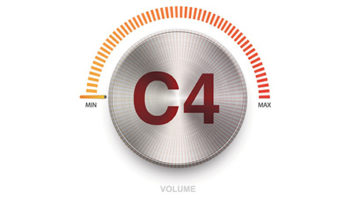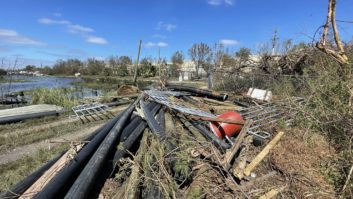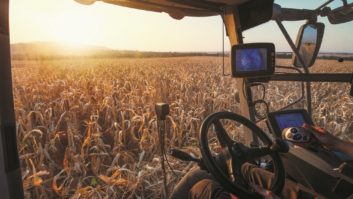The author is senior vice president, technology, of the National Association of Broadcasters.

Broadcasters cover a disaster in an image provided by FEMA.
credit: FEMA/Walt Jennings “Broadcasting Is Key Communication Medium in Emergencies.”
Doesn’t everyone already know that? Or is broadcast coverage of emergencies just taken for granted? Or perhaps forgotten about … until the next crisis hits? Or maybe a little of all-of-the-above?
In fact, that first sentence is the title of a late November press release from the International Telecommunications Union.
The ITU, the specialized agency of the United Nations dealing with RF spectrum management around the world, is taking a critical look at the value and importance of terrestrial radio and television broadcasting during emergencies. What is emerging out of that effort is the conclusion that broadcasting is an essential and critical part of public warning and information dissemination in times of crisis.
That’s no real surprise; but the global nature of the inquiry is yielding some instructive insights about the strength of broadcasting as an emergency information tool.
WHAT WE’RE LEARNING
A little background: Based on a contribution from the North American Broadcasters Association, a project for a new ITU Report on the importance of terrestrial radio and television broadcasting was approved at the ITU-R Study Group 6 (Broadcasting) meeting in April 2013.
I and Gary Stanley from Babcock International Group in the U.K. were assigned as co-rapporteurs for preparing the report; the draft was subsequently made available publicly in November, with the final report expected by April 2014.
So what can be learned so far from this project about the importance of broadcasters during emergency situations? As it turns out, quite a lot.
It is well known that broadcasting possesses an optimum set of technical and operational characteristics for providing critical information services during times of crisis:
• Broadcasting is a highly survivable medium. With wide area coverage, geographic diversity of stations, lack of intermediate potential points of failure between transmitters and receivers, evolved emergency plans and procedures and local power backups, broadcast services are more likely to survive crisis events than other communication networks. And unlike point-to-point wireless media, the broadcast network never gets congested due to its one-to-many architecture, keeping its system availability high no matter the circumstances.
• Broadcasters deliver high-quality news.With the initial role of emergency alerting, broadcasts quickly create public awareness. But alerts are brief and broadcasters then turn to more in-depth coverage of the situation before, during and after the event. Broadcasters are uniquely situated for such coverage, having journalistic credibility, a wide range of professional staff, the ability to aggregate diverse sources of information and established relationships with first responders, emergency agencies and other resources. And all of this has a uniquely local perspective, with broadcasters serving as trusted members of the local community.
• Broadcast receivers are ubiquitous. The inexpensive nature of broadcast receivers, especially radio, their portable profile, low battery drain and ubiquity in vehicles and growing prevalence in mobile devices constitute an ideal platform for delivering mass information during emergencies.
The advantageous characteristics of broadcasting are indeed well known; domestically, the role of broadcasting in emergencies in the U.S. has been amply documented and routinely reported.
These reports, combined with other individual anecdotes and case studies collected in the draft ITU report from around the world, tell a persuasive story about the overall global importance of terrestrial broadcasting.
A few examples from outside the U.S.:
• During the Great East Japan Earthquake in 2011, the media used for getting information soon after the event were radio (51 percent), television (21 percent) and “one seg” mobile TV (19 percent), showing the critically important role of broadcasting, since mobile phone calls and text messages were not available due to traffic congestion and damage to infrastructure.
• Ishinomaki City, badly damaged in the Great East Japan Earthquake, had no electricity for more than two weeks. At local commercial radio station Radio Ishinomaki, motorists and car show owners donated gasoline from their cars to keep the generator running so the station could stay on the air, reading out names of missing and deceased persons, and sharing experiences from listeners. No commercials were aired for weeks.
• Australia Broadcasting Corp.’s development of evolving procedures for issuing timely and repeated warnings for deadly bushfires via broadcast media, informing citizens and saving lives.
• First Response Radio, a global specialist organization for setting up radio services in disaster areas, describes their goal of putting a “radio station in a suitcase” on-air within 72 hours of a disaster, and some of their experiences with earthquakes in Indonesia and floods in India.
• BBC Media Action, the humanitarian aid arm of the BBC, and their experiences with “lifeline broadcasting,” delivering information and providing a voice to those in disaster areas or conflict zones, with examples from Bangladesh, Nepal, Sudan and others, and their finding that radio is usually the best way to reach people affected by a rapid-onset humanitarian crisis, even if the target audience relies on television or other media as its main source of news and information in normal times.
• The distribution of solar-powered and/or wind-up radios in disaster-affected communities without access to radio receivers. Since 2003, USAID has distributed more 200,000 radios in Sudan, in areas affected by conflict.
• The commitment of broadcasters in Latin America to disseminate life-saving information, to undertake ad campaigns and mobilize the public at crucial moments when other communication technologies fail.
• The shortwave frequency coordination work of the High-Frequency Coordination Conference, its conception of the International Radio for Disaster Relief project, and the usage of shortwave radio broadcasts in severe disaster situations where local and even regional communication networks are destroyed or overloaded.
It’s true that sometimes there is a human tendency to not see the forest for the trees. But close inspection of individual trees can help in recognizing common traits and ultimately appreciating that the trees do indeed form a great forest.
Taken together, the individual case studies in the ITU draft report combine to tell a compelling story about the essential services provided by broadcasting during emergencies, remarkably similar throughout the world, irrespective of political and geographic boundaries, with a simple message: broadcasting works!
The ITU press release I mentioned succinctly summarizes the value of broadcasters during emergencies with a quote from Christoph Dosch, chairman of ITU-R Study Group 6 (Broadcasting):
“With the number of natural disasters and other large-scale emergency situations on the rise around the world, as we have seen with the devastation caused by the recent Typhoon Haiyan, it is absolutely essential that the public is provided the necessary emergency information quickly, comprehensively and accurately. Terrestrial television and radio broadcasters provide the fastest, reliable and most effective means of delivering information to the public in these critical situations.”
Shouldn’t everybody know that? Help spread the word.
The ITU draft report and presentations from the affiliated ITU workshop on emergency broadcasting can be accessed at http://bit.ly/1bLjlay.
Comment on this or any story. Write to [email protected] with “Letter to the Editor” in the subject field.











